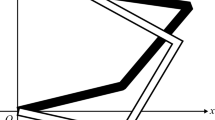Abstract
This contribution addresses forward kinematic solution of modular hybrid manipulator which includes two similar Stewart mechanisms in serial form, known as 2-(6UPS) manipulator. First, using geometrical and vectorial analysis, mathematical model of kinematic analysis for 2-(6UPS) is extracted. Due to highly nonlinear characteristic of kinematic model of 2-(6UPS), which is related to complicated configuration of manipulator, forward kinematic solutions of mechanism is so difficult. Therefore, we proposed artificial neural network based on wavelet analysis to resolve forward kinematics of 2-(6UPS). Also, we used wavelet neural network (WNN) to approximate specific trajectory in circle oscillates in z direction and spiral with semi-cardioid base paths for mid and upper platforms movement respectively. Comparison between the results of proposed network and closed form solution of kinematics for 2-(6UPS) shows proper performance of proposed network in \(<\)1 % error. Also, WNN results are verified by experimental results which are obtained by image processing.













Similar content being viewed by others
References
Rico J, Gallardo J, Duffy J (1999) Screw theory and higher order kinematic analysis of open serial and closed chains. Mechan Mach Theory 34(4):559–586
Carbone G, Ceccarelli M (2004) A stiffness analysis for a hybrid parallel–serial manipulator. Robotica 22(05):567–576
Carbone G, Ceccarelli M (2005) A serial–parallel robotic architecture for surgical tasks. Robotica 23(03):345–354
Zhou B, Xu Y (2007) Robust control of a 3-DOF hybrid robot manipulator. Int J Adv Manuf Technol 33(5–6):604–613
Cheng G, Gu W, Ge S-R (2012) Kinematic analysis of a 3SPS+ 1PS parallel hip joint simulator based on Rodrigues parameters. J Mech Sci Technol 26(10):3299–3310
Huang MZ, Ling S-H, Sheng Y (1993) A study of velocity kinematics for hybrid manipulators with parallel–series configurations. In: Proceedings of the 1993 IEEE international conference on robotics and automation. IEEE, New York
Romdhane L (1999) Design and analysis of a hybrid serial–parallel manipulator. Mech Mach Theory 34(7):1037–1055
Tanev TK (2000) Kinematics of a hybrid (parallel–serial) robot manipulator. Mech Mach Theory 35(9):1183–1196
Yang G, Chen W, Ho EHL (2002) Design and kinematic analysis of a modular hybrid parallel–serial manipulator. In: 7th international conference on control, automation, robotics and vision, 2002 (ICARCV 2002). IEEE, New York
Huang T et al (2005) Conceptual design and dimensional synthesis for a 3-DOF module of the TriVariant-a novel 5-DOF reconfigurable hybrid robot. IEEE Trans Robot 21(3):449–456
LiangZhi F, Elatta A, XiaoPing L (2005) Kinematic calibration for a hybrid 5DOF manipulator based on 3-RPS in-actuated parallel manipulator. Int J Adv Manuf Technol 25(7–8):730–734
Campos A, Budde C, Hesselbach J (2008) A type synthesis method for hybrid robot structures. Mech Mach Theory 43(8):984–995
Gallardo-Alvarado J et al (2008) Kinematics and dynamics of 2 (3-RPS) manipulators by means of screw theory and the principle of virtual work. Mech Mach Theory 43(10):1281–1294
Gallardo-Alvarado J et al (2008) Solving the kinematics and dynamics of a modular spatial hyper-redundant manipulator by means of screw theory. Multibody Syst Dyn 20(4):307–325
Gallardo J et al (2011) The kinematics of modular spatial hyper-redundant manipulators formed from RPS-type limbs. Robot Auton Syst 59(1):12–21
Hu B et al (2012) Analyses of inverse kinematics, statics and workspace of a novel 3RPS-3SPR serial–parallel manipulator. Open Mech Eng J 6:65–72
Li B, Zhao W, Deng Z (2012) Modeling and analysis of a multi-dimensional vibration isolator based on the parallel mechanism. J Manuf Syst 31(1):50–58
Chen C-T, Pham H-V (2012) Trajectory planning in parallel kinematic manipulators using a constrained multi-objective evolutionary algorithm. Nonlinear Dyn 67(2):1669–1681
Ahmad Ghanbari AR (2013) Neural network solutions for forward kinematics problem of hybrid serial–parallel manipulator. World Sci J 1(8):148–158
Pedrammehr S, Mahboubkhah M, Khani N (2012) Improved dynamic equations for the generally configured Stewart platform manipulator. J Mech Sci Technol 26(3):711–721
Pedrammehr S, Mahboubkhah M, Khani N (2013) A study on vibration of Stewart platform-based machine tool table. Int J Adv Manuf Technol 65(5–8):991–1007
Qazani MRC et al (2014) An experimental study on motion error of hexarot parallel manipulator. Int J Adv Manuf Technol 72(9–12):1361–1376
Qazani MRC, Pedrammehr S, Rahmani A, Danaei B, Ettefagh MM, Rajab AKS, Abdi H (2015) Kinematic analysis and workspace determination of hexarot-a novel 6-DOF parallel manipulator with a rotation-symmetric arm system. Robotica 33:1686–1703. doi:10.1017/S0263574714000988
Zhang Q, Benveniste A (1992) Wavelet networks. IEEE Trans Neural Netw 3(6):889–898
Banakar A, Azeem MF (2008) Artificial wavelet neuro-fuzzy model based on parallel wavelet network and neural network. Soft Comput 12(8):789–808
Huang M, Cui B (2005) A novel learning algorithm for wavelet neural networks. In: Advances in natural computation. Springer, Berlin, pp 1–7
Chen D, Han J (2011) Application of wavelet neural network in signal processing of MEMS accelerometers. Microsyst Technol 17(1):1–5
Author information
Authors and Affiliations
Corresponding author
Appendix
Appendix
In this paper, we specified two different trajectories for centre point of moving (mid and upper) platforms. The mentioned trajectories are included equations for displacement of \((x, y ,z ,\alpha , \beta , \gamma )\) in time (t) for centre point of moving platforms.
-
Mid plate:
Trajectory of mid platform is oscillating circle as follows:
$$\begin{aligned} x^{\mathrm{m}}(t)= & {} 200 \sin \left( \frac{\pi }{6.3}t\right) \cos \left( \frac{\pi }{6.3}t\right) \end{aligned}$$(31)$$\begin{aligned} y^{\mathrm{m}}(t)= & {} 200 \sin ^{2}\left( \frac{\pi }{6.3}t\right) \end{aligned}$$(32)$$\begin{aligned} z^{\mathrm{m}}(t)= & {} 20 \sin (4t) \end{aligned}$$(33)$$\begin{aligned} \alpha ^{\mathrm{m}}(t)= & {} \beta ^{\mathrm{m}}(t)=\gamma ^{\mathrm{m}}(t)=0 \end{aligned}$$(34) -
Upper plate:
Trajectory of upper platform is spiral with semi-cardioid base as follows:
$$\begin{aligned} x^{\mathrm{u}}(t)= & {} 150\sin \left( \frac{t}{2}\right) \cos \left( \frac{\pi }{2} \cos \left( \frac{t}{2}\right) \right) \end{aligned}$$(35)$$\begin{aligned} x^{\mathrm{u}}\left( t\right)= & {} 150\sin \left( \frac{t}{2}\right) \sin \left( \frac{\pi }{2} \cos \left( \frac{t}{2}\right) \right) \end{aligned}$$(36)$$\begin{aligned} x^{\mathrm{u}}(t)= & {} 15t \end{aligned}$$(37)$$\begin{aligned} \alpha ^{\mathrm{u}}(t)= & {} 0 \end{aligned}$$(38)$$\begin{aligned} \beta ^{\mathrm{u}}(t)= & {} -10 \sin (t) \end{aligned}$$(39)$$\begin{aligned} \gamma ^{\mathrm{u}}(t)= & {} 5 \sin (t/2) \end{aligned}$$(40)
Rights and permissions
About this article
Cite this article
Rahmani, A., Ghanbari, A. Application of neural network training in forward kinematics simulation for a novel modular hybrid manipulator with experimental validation. Intel Serv Robotics 9, 79–91 (2016). https://doi.org/10.1007/s11370-015-0188-8
Received:
Accepted:
Published:
Issue Date:
DOI: https://doi.org/10.1007/s11370-015-0188-8




